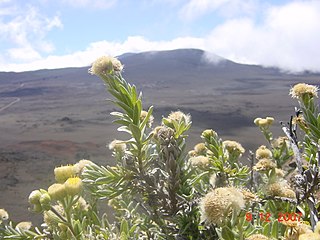Abarema obovata, the obovate abarema, is a species of plant in the family Fabaceae. It is endemic to the wooded hillsides of east and north-central Minas Gerais, Brazil.
Pluchea glutinosa was a species of flowering plant in the sunflower family that was endemic to the Island of Socotra in the Indian Ocean, part of the Republic of Yemen.

Psiadia, commonly known as daisy trees, is a genus of mostly woody Asian and African plants in the tribe Astereae within the family Asteraceae. The genus is distributed throughout the Western Indian Ocean, with species reported from continental Eastern Africa, Madagascar, Mauritius, La Reunion, Rodrigues, the Comoro islands, as well as several of the smaller, uninhabited islands in the Mozambique Channel. Additional species are suspected on Socotra and Sri Lanka, but these have not been confirmed. Phylogenetic studies using DNA sequence data and biogeographic reconstruction using molecular dating have shown that the genus originated on the African mainland, and colonized Madagascar and the outlying islands in the Indian Ocean in several independent instances of overwater dispersal in the Miocene.
Draba obovata is a species of plant in the family Brassicaceae. It is endemic to Ecuador. Its natural habitats are subtropical or tropical high-altitude grassland and rocky areas. It is an IUCN Red List Near threatened species, threatened by habitat loss.
Dirichletia obovata, synonym Carphalea obovata, is a species of plant in the family Rubiaceae. It is endemic to Socotra. Its natural habitat is subtropical or tropical dry forests.
Cassipourea obovata is a species of plant in the Rhizophoraceae family. It is endemic to Mozambique.
Freziera obovata is a species of plant in the Pentaphylacaceae family. It is endemic to Ecuador.
Habenaria obovata is a species of plant in the family Orchidaceae. It is endemic to Cameroon. Its natural habitat is subtropical or tropical dry lowland grassland.
Haya is a monotypic genus of plant in the family Caryophyllaceae. It is endemic to Yemen's Socotra island. As of March 2014 The Plant List recognises the single species Haya obovata. Haya obovata grows in subtropical or tropical dry shrubland and rocky areas.
Iryanthera obovata is a species of plant in the family Myristicaceae. It is endemic to Brazil.

Melicope obovata, also called Makawao melicope or ovate melicope, was a species of plant in the family Rutaceae. It was endemic to the Hawaiian Islands.
Monnina obovata is a species of plant in the family Polygalaceae. It is endemic to Ecuador.
Myrsine obovata is a species of plant in the family Primulaceae. It is endemic to French Polynesia.
Schoepfia harrisii is a species of flowering plant in the Schoepfiaceae family. It is a small tree or shrub, growing two to five metres tall. It is endemic to Jamaica, where it is only known to occur in the parishes of Trelawny and Clarendon, in what is known as Cockpit Country, a region of many steep, rounded, limestone hills, shaped like an egg-carton. Here it grows on crags in moist woodland, between 600 and 900m in elevation.
Semecarpus obovatus is a species of plant in the family Anacardiaceae. It is endemic to Sri Lanka. The specific epithet was originally spelt obovata.
Vatica obovata is a species of plant in the family Dipterocarpaceae. It is a tree endemic to Sumatra. It is a critically endangered species threatened by habitat loss.

Kandelia obovata is a species of plant in the Rhizophoraceae family, i.e. a kind of mangrove. It is found in Vietnam, Natuna Islands of Indonesia, Southern China, Hong Kong, Taiwan, and Japan. Its presence in the Philippines is possible but not confirmed.

Kandelia candel is a species of mangrove in the family Rhizophoraceae, found around the coasts of South Asia and Southeast Asia, from western India to Borneo. Populations further east, from Vietnam to Japan were formerly included in K. candel, but are now considered a separate species, K. obovata.

Cornutia obovata is a rare species of tree in the mint family, and formerly considered a member of the verbena family. It is endemic to forested slopes in Puerto Rico, where its common names are capá jigüerilla, nigua, and palo de nigua. When it was added to the endangered species list of the United States in 1988 there were only seven individuals known to remain in the wild. By 1998 there were eight plants known. This is considered one population divided amongst a few locations in the mountain forests of the island.






